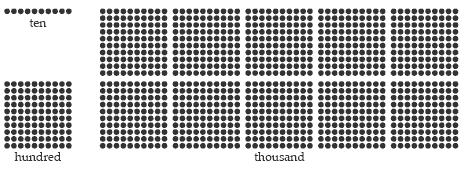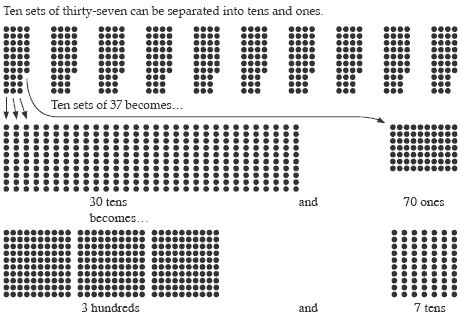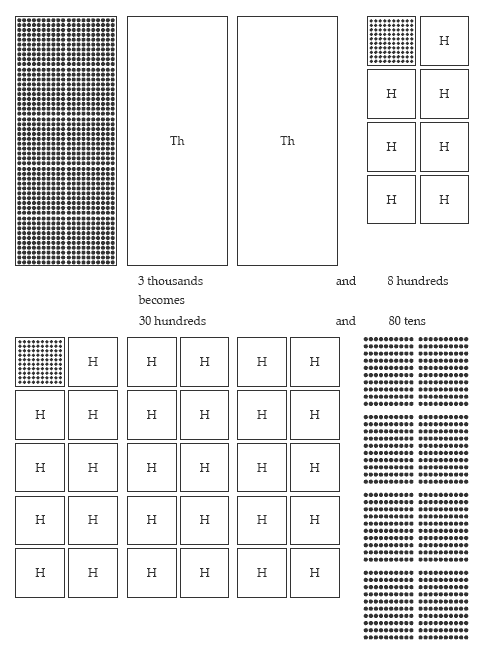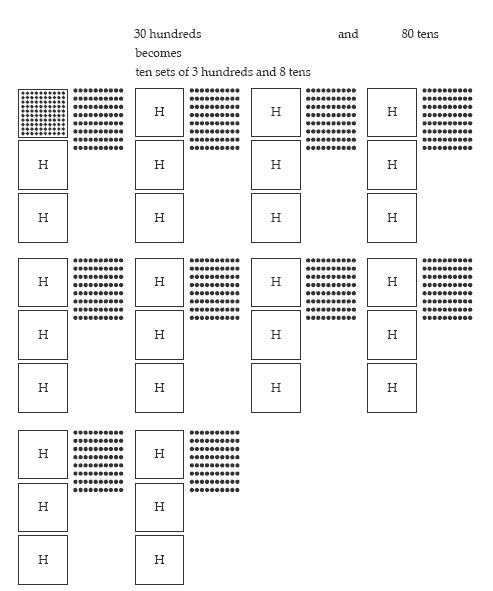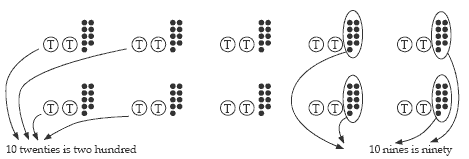Multiply by 10s, 100s, 1000s, and other multiples of 10.
Number Framework Stage 6
Scissors
Using Materials
Students unfamiliar with dotty arrays will need to become familiar with the representation of 1, 10, 100, 1 000, and so on as arrays of single dots. This will help them to recognise the relative value of the places
Ask ten students to make a two-digit number, e.g., 37, using the dotty array pieces. Pose this problem: “Imagine there are ten students and they each have 37 marbles/ apples/CDs.” Put the sets of 37 into a central space. “How many dots is that altogether?”
Some students are likely to have symbolic algorithms, such as “add a zero”, that enable them to get an answer of 370. Examine the actions on materials that explain the use of zero as a place holder. For example:
Using a place value chart, connect 37 with the result of 10 x 37
Students may notice that multiplying by one hundred has the symbolic effect of shifting each digit two places to the left. Transfer the focus to dividing by ten and by one hundred. Begin with a four-digit number like 3 800 (zero in the tens and ones places). Make this number with dotty array pieces.Pose this problem: “I have 3 800 marbles and I am going to share them equally among all ten of you. How many marbles will you get each?&rdquoAsk the students to predict the result of the sharing, and then confirm it by modelling with the materials:
The result of dividing 3 800 by ten can be shown on a place value chart as
The symbolic effect of dividing by ten is to shift the digits of the dividend (3 800) one place to the right. Ask the students to predict what the result would be if they
shared 3 800 into one hundred equal sets. Expect them to realise that the shares
would be one-tenth of 380, which is 38.
This may need to be acted out by cutting the 3 hundreds in 30 tens and the 8 tens
into 80 ones so the tenth shares can be established. Use the place chart to connect
3 800 and the result of 3 800 ÷ 100 = 38. In this case, the symbolic effect is a two-place shift to the right.
Pose several similar multiplication and division problems by ten and one hundred,
expecting students to anticipate the results and justify their prediction through
explanations about the quantities involved. The dotty arrays can be used to check
the explanations where uncertainty exists.
Using Imaging
In this phase of the lesson, the focus is on students anticipating the actions on
materials, explaining their predictions quantitatively, and drawing diagrams to
explain the transformations on the numbers. In the process of this imaging phase,
recording in word form needs to be connected to the formal arithmetic symbols.
Pose problems such as:
“Tess pays her ten workers 29 pellowmuffs each. How many pellowmuffs does she
pay out altogether?”
Students might use diagrams or words to describe their methods of working out the
answer. For example:
“Ten workers get 29 pellowmuffs each like this …”
Using Number Properties
Pose problems like these below, expecting the students to reason the answers using place value understanding. The students must be able to justify their answers by explaining what occurs with the quantities involved.
1. 100 sets of 376 (100 x 376 = 37 600)
2. 960 shared among 10 people (960 ÷ 10 = 96)
3. 30 sets of 40 (30 x 40 = 1 200)
4. 4 300 shared among 100 people (4 300 ÷ 100 = 43)
5. 20 sets of 56 (20 x 56 = 1 120)
6. $5,000,000 shared among 1 000 people ( 5 000 000 ÷ 1 000 = $5,000)
